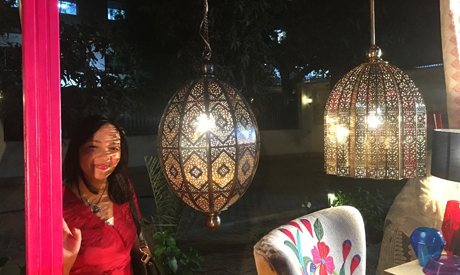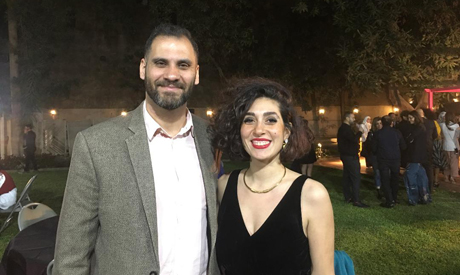The garden was buzzing with guests and art lovers from across the spectrum of Egyptian society, and at the far end of the venue, one could spot the array of colours at the mini pavilion, adorned with gems of pure Egyptian creativity and innovation.
In every corner of the pavilion were exhibits that speak of Egyptian culture and art and beauty.
The event, held on 23 April, marked a gathering of 13 innovative designers from Egypt, carefully chosen to represent the country in the first-ever representation by Egypt in the WantedDesign pavilion at New York design week.
For the first time, the US embassy in collaboration with the Egyptian government's Industrial Modernisation Centre (IMC) support the participation of Egypt in WantedDesign Manhattan during NY Design Week.
For some years now, WantedDesign has been regarded as a hub of new ideas and an extended artistic platform where designers from all over the world gather to celebrate innovation and creativity
The Egyptian pavilion, named “(re)New (re)Work," creates connection between entrepreneurs from Egypt and all over the world
New York design week takes place this year from 10 to 22 May. For the very first time, a uniquely curated pavilion that reflects Egypt's fine craftsmanship and materials will be showcased to world-renowned designers, editors, curators and design appreciators.

REFORM plastic recycled
"The different aesthetics of the designs are diverse. Nevertheless, they all reflect how the designers and artisans are connected by their interest and passion for local materials and crafts, and their challenge is to find their way from there to further introduce themselves to the foreign stakeholders and expand their work," Mohamed El-Shahed, curator of (re)New (re)Work, told Ahram Online.
WantedDesign is one of the most sought after exhibitions, and this year the IMC was appointed to select 13 names of those who can channel the inner beauty of the Egyptian art and culture through their work.
“While selecting the designers, we made sure they all represent Egypt in terms of the local identity reflected in their designs. However, this was not our sole criteria; the selection was rather based on the functionality, cost effectiveness and sustainability of the brands,” IMC marketing manager Nagwa Hussein said in a statement prior to the event.
Hussein told Ahram Online that the selection process was through a panel from the IMC and the US embassy, and took last May to select 13 out of 150 competitors.
"What is shown today is just a mini pavilion, with the main one in New York reaching up to 30 sq meters in size, and showcasing the story behind each participant," she said.
Ahram Online met with the 13 carefully selected designers, whose products vary in their aesthetics, but they all share a connection of interest and passion for local materials and crafts.

Israa's work of Marmar

Yasmin Fahmy intricate brass
Israa Fathy's products spoke of the endeavours to reach out to Luxor's people who had been adversely affected in the past year by the dip in tourism, and saw in Israa's Luxmar initiative an opportunity to revive their craft of Marmar (soft alabaster) products.
The beauty of brass and copper work shone through the intricately made oriental lanterns of Yasmin Fahmy, who acquired a passion for art in her teens and became an award-winner in the field of copper work in her twenties.
Hand-blown glass bulb techniques were showcased in the work of Salma Hassan's Kelos, who spoke to Ahram Online about the family glass industry and using the flame working technique, which is mostly common in Egypt rather than globally, to produce her contemporary design with an oriental feel.
Mizaj tiles showcased their works of beautifully crafted cement tiles that manifests an aspect of Egyptian heritage, while Reform drew much attention with their recycling of plastic to produce durable pieces of art that can endure and reflect beauty.
In the far corner, a silver chair stood out, sampling the collection that the famous Cairopolitan was selected to exhibit. It spoke of the well-known concept of promoting the Egyptian identity through objects that embody the spirit of contemporary Egypt and its pop culture.

Cairoplolitan's El Sharkawy&Hifnawy
Cairopolitan duo Ahmed El-Hifnawy and Nelly El-Sharkawy told Ahram Online about the initiation of the idea in 2006 and their constant inspiration from every day products that are found in Cairo' urban life.
"Each piece has its own appreciation, not only by Cairenes but people from all over the world, because each piece of art has its unique story embedded in the Egyptian memory and culture," they said.
Salsabeel's lighting material spoke of the authenticity of raw materials, while INCA'S furnishing products reflected the love of different cultures and globetrotting.
Brimming with energy was Rasha El-Gammal, who showcased her products made of traditional Egyptian Khaiamia embroidery and materials.

Rasha El Gammal Khayamia work
"I am super excited to expose people of different nationalities to the beauty and richness of our textile art and beauty," she said.
El-Gammal attributes her love of authenticity to late Egyptian TV presenter Samia El-Etriby, who pioneered tackling deep rooted topics and Egyptian arts. El-Gammal stressed that she remains keen to work with underprivileged craftsmen and women to revive the traditions in a contemporary form.
The same passion about preserving crafts was shared by Nada Attalla, who spoke on behalf of the Kilim team, saying that the city of Foa in Kafr El-Sheikh governorate was the hub of the traditional craft of hand-woven rugs called kilim, and that they aimed at reviving the craft by introducing modern design to time-honoured technique used in that city.

Kilim's Nada Attallah( All photos by Ingy Deif for Ahramonline)
From chairs and lighting units to rugs and accessories, the pavilion concept of “(re)New (re)Work" will showcase products from Egyptian resources such as Marmar (soft alabaster), marble, brass and copper to pottery, glass and wood, reviving traditional crafts while incorporating them in diverse innovative objects.
Short link: